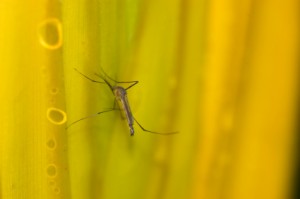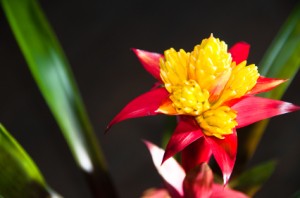Bromeliads and Mosquitoes
Author: Taber8 Comments
Bromeliads have few pests that damage the plant. The most harmful being mealybugs and aphids. However, there is one human pest that can thrive in a bromeliad. While mosquitoes do no damage to the bromeliad plant, they can be a nuisance to both the bromeliad grower and their neighbors. There are a few ways to control mosquitoes and reduce the number of itchy red welts on your body.
In order to understand how to control mosquitoes in bromeliads, you must know a little about bromeliads along with the life cycles of mosquitoes.
Bromeliad Overview

Mosquito on Yellow Flower
Most bromeliads have a feature unique to the family. They do not take up water or nutrients through their roots. Instead, the leaves come together to form a rosette shape. Depending on the species, this rosette shape creates a tank that collects water and other debris from the air. This rosette can be at each axil where the leaves meet or one main tank at the center of the plant. Rainwater falls in to these natural cups and sits. The bromeliad then takes it in as needed through a special structures called trichomes. The trichomes give the bromeliad the ability to absorb the water through its leaves. Debris from the trees in upper parts of the canopy, dust and even insects also fall into these bromeliad tanks. These items break down as they decompose in the water found in the tanks. This is how the plant absorbs the nutrients needed to grow. In most cases, bromeliad roots act only as anchors holding them in trees, on rocks or in the dirt. Some bromeliads do not form tanks such as the ever-present Spanish Moss and others in the Tillandsia genus.
Bromeliads thrive outdoors usually in lightly shaded, humid areas. They cannot tolerate frost and are therefore found outside in more tropical climates. Many growers in southern states, such as Florida, enjoy growing bromeliads as part of their landscape. Bromeliads found in these location function very similarly to bromeliads found in the wild collecting rainwater and thriving under canopies of light shade.
Unfortunately mosquitoes thrive in the same types of environments as bromeliads. They enjoy warm, humid, lightly shaded areas and require sitting water to lay and hatch eggs. Bromeliad tanks provide the perfect environment for mosquito reproduction.
Life Cycle of the Mosquito
We are used to seeing mosquitoes buzzing around our ears and biting our ankles. However, mosquitoes do not start out as flying insects. Mosquito eggs are either laid in water or in moist places waiting for water to flood the area. The eggs must have standing water to hatch. The larvae are also aquatic and feed off of nutrients and debris found in the standing water. The pupa stage is next, during which the mosquito does not feed. The mosquito finally emerges as a flying adult once the pupa stage is complete. Depending on the species of mosquito and the temperature of water, the whole process egg to flying adult can take anywhere from four days to a month.
Ideal Temperatures
Mosquitoes cannot function in the winter. Depending on the species they either die before a frost or hibernate when the temperature becomes too cold. They prefer temperatures around 80 degrees F and cannot tolerate temperature drops below 50 degrees F. This makes the same tropical environments that are ideal for the outdoor growth of bromeliads, similarly ideal for year round mosquito production.
Behind the Bite
As adults, only the female mosquitoes bite. The female mosquitoes extract blood from warm blooded creatures. This blood provides the needed protein for egg production. Male mosquitoes do not need blood to reproduce and therefore do not bite. So for each population of mosquitoes that is hatched roughly half will have bitten people and animals. The bite becomes itchy, red and swollen because of the saliva from the mosquito that is injected into the skin at the time of the bite. In some cases, mosquitoes cause damage beyond the pain and irritation of a bite. They can transfer diseases that are caused by protozoa, nematodes and viruses to people and animals. Only certain species carry certain diseases. This is why some mosquito born diseases are problems only in specific areas. For example, malaria has been eradicated in the United States, but is a prevalent problem in Africa and South America. Other mosquito borne diseases included, dengue, yellow fever, west nile virus, various forms of encephalitis and, in animals, heart worms.
There are 3000 species of mosquitoes in existence and currently only two are known to specialize in reproduction in bromeliad tanks. The Wyeomyia vanduzeei and Wyeomyia mitchellii are keenly adapted to life in bromeliads. Fortunately, these two species are currently not known to transmit diseases. They are simply a nuisance. Unfortunately the Culex and Aedes genera, which can transmit disease, do have some species that will occasionally grow in bromeliad tanks. It is a very small percentage of the overall mosquito population, but precautions can prevent them from reproducing in landscapes that include bromeliads.
Methods for Control

Blossoming Bromeliad Plant
With the understanding of how both mosquitoes reproduce and how bromeliads gather nutrients and grow, you can begin to develop a method for controlling mosquitoes. The University of Florida Entomology Department does not recommend the use of chemical insecticides. The Wyeomyia are most active during the daytime and are not susceptible to night time fogging. Fogging is the typical community wide mosquito management method. Chemicals can be applied directly to the bromeliad plant. However, the chemical insecticides will kill all populations of insects found in the bromeliad tanks. The chemicals will lose their potency and the larvae will feed on the nutrients in the tank without any competition. This will result in adults that are capable of laying more eggs and any damage done to the mosquito population will be easily replaced in a short period. The only way for chemicals to work is to use constant, repeated application, which eventually will not be cost effective.
Bacillus is a bacteria that can be introduced that may significantly reduce Wyeomyia populations for a period of time. Unfortunately the Bacillus does not negatively effect other genera of mosquitoes such as the Culex.
Regularly flushing a bromeliad’s tank with a garden hose can also reduce mosquito populations. The pressure will force the eggs out onto the ground, where they cannot survive. It will also remove the debris, which contributes the nutrients necessary for the larvae to grow into a mature adult. If you use this method you must replace the lost nutrients with fertilizers specialized for bromeliads.
With diligence and care, you can avoid aiding the rapid production of mosquitoes in your back yard. If you have only a small collection of bromeliads, they are not likely to contribute significant mosquito populations to the neighborhood. But if you are a bromeliad enthusiast and your landscape is made up of many tank forming bromeliads, you may want to consider whether or not mosquitoes are a pest problem for you and your neighbors. If they are, find a management approach that will reduce the population of the mosquitoes to a more manageable level. If possible, avoid using chemicals so that the ecosystem in your yard will stay healthier in the long run.
Sources
Frank, J.H. Bromeliad-inhabiting mosquitoes in Florida. <http://BromeliadBiota.ifas.ufl.edu/mosbrom.htm>
FAQ’s on Mosquitoes. Rutgers Center for Vector Biology. <http://www-rci.rutgers.edu/~insects/mosfaq.htm>
Bromeliads and Mosquitoes. Pinellas County. <http://www.pinellascounty.org/PublicWorks/mosquito/pdf/bromeliads-and-mosquito-control.pdf>
8 Responses to “Bromeliads and Mosquitoes”
Leave a Reply

Resource Download
Hechtia Care Cheat Sheet
Learn how to care for your Hechtia bromeliad with this quick and easy informational guide.
Learn More
Ask an Expert
Questions about bromeliads?
Our experts love a challenge!
Photo of the Week
Submit your photo to be featured on the blog!
More Photo of the Week Winners
Submit Photo








Another thing you could try is to raise dragonflies and bats, the natural enemies of the mosquito. Dragonflies need a larger body of water to mature, like a pond or water feature, and will eat mosquitoes in and out of the water. Bats can be attracted by constructing bat houses, and can eat up to 1000 mosquitoes an HOUR.
Will an eyedropper of peanut or okive oil in te bromeliad’s tank harm the plant?
In another meme was stated one drop of cooking oil about every 20 to 30 days would take care of it.
I’ve been flushing my bromeliads once a week with environment friendly laundry detergent, is there a specific brand you know of that works best?
What kind of soap or spray
I have my tank bromelaids in pots. Before flushing the bromeliads I usually throw out the old water. I have not noticed any mosquito larvae in the water. What I do notice is at least two baby frogs. I would want to conclude that the baby frogs eat the larvae.
That’s a wonderful little eco-system you have going there!
bottom leaves falling off and now another row is doing the same thing??